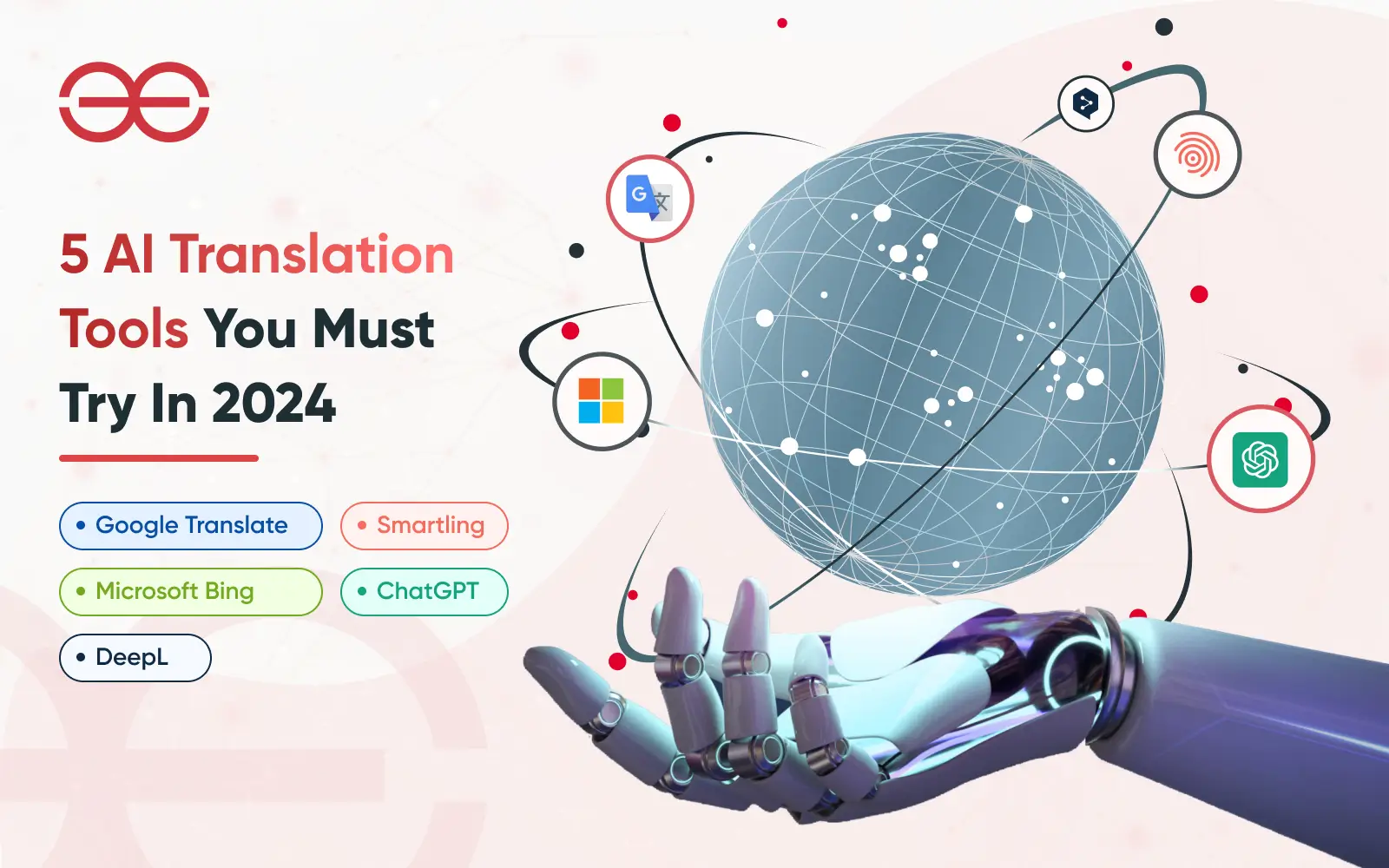Imagine a world where language is no barrier – where websites, documents, and conversations can be instantly translated between any two languages. While this may have sounded like science fiction just a few years ago – recent leaps in AI are turning this into reality.
With just one click, AI translation tools can now convert websites, documents, and more between over 100 different languages. Much more than a dictionary, these technologies instantly translate content while retaining context, tone, and accuracy.
In this blog post, we will walk you through some of the most promising open AI translation tools making waves in 2024. Whether you need to translate documents, websites, apps, or videos, these tools can significantly enhance productivity and reach while maintaining quality.
Read on for our pick of the 5 best AI translation tools to try in 2024 and beyond.
Table of Contents
ToggleAI Translation Vs Machine Translation
AI translation is the most modern form of machine translation, powered by artificial intelligence technologies like neural networks and deep learning. Unlike rules-based machine translation systems that rely on language rules and dictionaries, AI translation utilizes powerful algorithms that understand real-world linguistic contexts the way humans do.
AI translation tools continuously learn and improve themselves based on huge volumes of data. This results in much more accurate and fluent translations that sound human-generated. AI translation represents the cutting edge in translation automation and outperforms any rules-based machine translation system.
5 Best AI Translation Tools
Machine translation tools powered by AI are revolutionizing how we communicate across languages. AI-enabled translation provides fast, accurate, and cost-effective translation services to individuals and businesses.
There are now many options for AI-powered translation services available. Here are 5 of the best Artificial Intelligence translation tools available today:
-
Google Translate
Google Translate is one of the most popular AI-powered translation tools available today. It uses Google’s own neural machine translation technology, which provides very fast and accurate translations for common language pairs like English to Spanish or French.
Google Translate supports over 100 different languages including Chinese, Arabic, Hindi, Thai, Russian, and many more.
Some key features of Google Translate include the ability to translate blocks of text, entire documents, websites, and even camera images in real time using your device’s camera. Besides, it has a conversation mode that allows back-and-forth translations useful for travelers.
Being among the best AI translation tools – it is tightly integrated into other Google products and services like Gmail, Chrome browser, Google Docs, and more. There are also mobile apps available for both Android and iOS devices. Google Translate is free to use but has limits on the number of texts and images you can translate per day before needing to sign up for a paid plan.
It offers customized translation services for business customers looking for advanced features like API/plugin integration, customized engines, and expert support.
-
Microsoft Translator
Microsoft Translator is an artificial intelligence-powered translation service developed by Microsoft researchers leveraging cutting-edge neural network technology. It provides high-quality and accurate translations for common language pairs – including English to Spanish, French, and Chinese.
Microsoft Translator supports text translation for over 70 of the most popular global languages like Arabic, Russian, Japanese, and Portuguese.
However, some of the key features include not just text translation but also voice translation and photo translation capabilities. It can even transliterate between writing systems when direct translation is not available. Seamless integration with Microsoft products and services like Office 365, Skype, Bing, and the Edge browser makes Microsoft Translator easily accessible to millions of users worldwide.
Plus, the apps are also available for Windows, iOS, and Android mobile devices so you can translate on the go. Moreover, its basic translation service is available for free up to 2 million characters per month before needing to upgrade to a paid plan for higher monthly usage.
-
DeepL Translator
So far, DeepL is among the top AI translation tools available. This translator utilizes proprietary deep-learning neural network technology to produce extremely accurate translations for many European language pairs. Besides, it has a particular strength in translating between English, French, Spanish, Italian, German, Dutch, and Polish.
Most importantly, DeepL’s advanced algorithms provide translation quality that is often superior to other machine translation tools.
Its interface is clean and simple, allowing users to easily type or paste text to be translated. This translator also features a document translator that can handle Word, PowerPoint, and PDF files. DeepL integrates smoothly with many other apps through API integration and browser extensions. However, there are no official mobile apps for DeepL yet.
The basic DeepL Translator is free to use but limited to 500,000 characters per month. However, if you need unlimited translations, you can opt for premium paid subscription plans.
For individuals or companies needing high-precision translations between popular European languages, DeepL Translator is an excellent choice with its deep learning approach producing remarkable translation accuracy in these language combinations.
-
Systran
Systran is a pioneering machine translation company with over 50 years of experience developing translation technologies. Although there are numerous AI translation tools, Systran uses a different approach. It combines the linguistic rules of classic rule-based machine translation with the pattern recognition of modern neural machine translation.
This hybrid model allows Systran to offer translations for over 140 different language pairs including major languages like Arabic, Korean, Japanese, and Chinese.
The translator provides advanced text analytics and linguistic tools tailored for enterprise customers. Their software allows large organizations to build and customize their own translation engines using their specific data and content. The systems integrate directly into business workflows through APIs, plugins, and connectors.
Unlike consumer-focused MT tools, Systran uses a subscription-based pricing model for the premium software targeted at large corporations, global enterprises, government agencies, and NGOs. Furthermore, the subscriptions are tailored to each customer’s needs in terms of number of users, integration requirements, and volume of translations.
With its long history of developing translation technology and focus on enterprise needs, Systran is an ideal choice for large organizations with complex translation requirements across many languages.
-
DeepL
This open AI translation utilizes deep neural networks to deliver extremely high-quality and accurate translations. It is especially adept at translating between common European languages like English, French, German, Spanish, and Italian.
Better yet, the advanced deep learning algorithms allow Deepl to understand context and provide translations that are more fluent and human-sounding compared to other machine translation tools. One of the standout features of Deepl is the intuitive user interface that makes it easy for users to quickly translate text by typing or copy-pasting into the text box.
The basic translator is available for free but has usage limits unless you upgrade to a paid subscription plan which allows unlimited translations. The paid plans also provide access to premium features like document translations and an API for integration with other apps.
For both individual users and businesses, Deepl offers a simple yet powerful translation solution for common language pairs like English to French. With its deep neural network-powered engine, it produces astonishingly human-sounding translations that other translation tools cannot match.
So far, these are the 5 best AI translation tools that you could use for exceptional translation.
Why do Companies use AI Translation Tools?
Here are some of the key reasons why companies use AI translation services:
- Save Time and Costs – AI translation is much faster than human translation and more cost-effective at scale. It allows companies to translate large volumes of content quickly and affordably.
- Increase Global Reach – AI translation helps companies easily localize content and products for international markets, expanding their global footprint.
- Improve Consistency – AI systems translate content in a consistent style and tone across multiple languages.
- Enable Multilingual Customer Service – Chatbots and virtual assistants powered by AI translation can serve customers in many languages.
- Accelerate Product Cycles – AI speeds up the translation of manuals, support docs, websites, and other collateral, allowing faster product launches globally.
- Improve Employee Productivity – Employees can communicate across language barriers using AI-enabled translation tools.
- Provide More Content – AI translation allows companies to economically translate more support articles, marketing copy, e-commerce content, etc.
- Analyze Foreign Language Content – AI translation combined with text analytics can help understand foreign language customer feedback, reviews, social media, etc.
Closing Thoughts…
Indeed, AI translation tools are evolving rapidly, empowering global communication like never before. As we have explored, there are now countless innovative options for unlocking multilingual content and interactions. However, leading solutions like Google and Microsoft enable translating everything from documents to speech with just one click. At the same time, disruptive startups like DeepL are raising the bar on translation quality through cutting-edge advancements.
With the top tools featured in this post, you can surpass language barriers for a wide range of personal and business needs. From enhancing global reach to streamlining workflows, integrating AI translation can transform how you operate and connect across cultures.
But translation powered by artificial intelligence still has huge horizons ahead. We hope this overview has shed light on the exciting possibilities now within reach in 2024 and provided a useful launch pad to enhance your multilingual endeavors.
BTW: if you need assistance with generative AI and Chatbot integration – Geeks of Kolachi has the skills and expertise to help you successfully implement these technologies.
Frequently Asked Questions
- How accurate are AI-powered translations compared to human translators?
AI translation tools have improved tremendously in accuracy due to advances in machine learning. While human translation is still superior for complex content, AI tools now offer over 90% translation accuracy for most general use cases. For casual translation, AI is very effective.
- What types of content can I translate with AI translation tools?
Most AI translation tools support text translation for documents, websites, messages, and more. Many also allow audio and video translation, translating speech in videos and calls. Translation of images with text via OCR is also becoming more common.
- Which languages are supported by AI translation tools?
The top services support translation between over 100 different languages including Spanish, French, German, Portuguese, Chinese, Japanese, Italian, and many more. Google Translate supports 133 languages!
- Is AI or human translation better for official business content?
For marketing materials, websites, legal documents, and other official business content, human translation is still the safer choice. Humans handle nuanced phrasing better. But AI works for more casual everyday business communications.
- Are AI translations secure and confidential?
Leading AI translation tools offer encryption and confidentiality safeguards. But for very sensitive content, having translators sign NDAs may still give greater peace of mind over AI tools.

